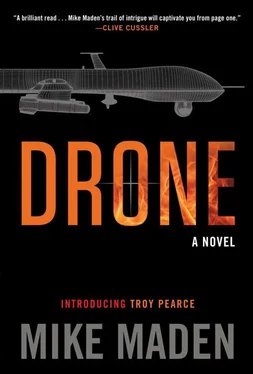Pearce wasn’t rated to fly the twin-engine turbofan jet, but he’d practiced on the simulator a half dozen times. He was also pretty good at flying single-engine props and had gotten better at it thanks to Judy’s patient instruction. But he didn’t have a fraction of the natural skill that Judy possessed.
Judy sensed his hesitation. “If you’re not ready, that’s okay. She’s a handful, for sure.”
“Just like every other woman in my life,” Pearce said. He knew it was foolish to not let the far superior pilot take control of the aircraft, but Pearce couldn’t resist the rush of controlling a four-thousand-feet-per-minute climb. Besides, it was his damn plane. “Let’s rock and roll.”
Judy winked. “That’s what I wanted to hear.” She called in to the tower one last time. They were cleared for takeoff. Pearce fired up the Stones’ “Gimme Shelter” on the comm, then slammed the throttle home, rocketing the HondaJet down the tarmac. The plane leapt off the runway, blasting into the crisp morning sky like a mortar round, grins plastered on both of their faces.
Pearce Systems Research Facility, Dearborn, Michigan
Pearce’s main research facility was located in an abandoned Mercury auto plant just south of I-94, a stone’s throw from the General George S. Patton memorial. Pearce and his mysterious investing partner had purchased it just after the ’08 crash to house their expanding research operations, which provided a significant revenue stream for the company beyond the various civilian and security services they provided.
For most of his missions, Pearce purchased off-the-shelf operational systems from legitimate vendors, often modifying them to his own specs. If particular drone systems weren’t available for purchase, he was able to emulate their capabilities by manufacturing his own either by original design or by purchasing widely available airframe, power plant, and avionics components.
But Pearce Systems was also pioneering some of the latest drone technologies by partnering with or building upon the efforts of other bleeding-edge research organizations. Pearce and Judy had made the flight to the Dearborn lab that morning at the fevered request of Dr. Kirin Rao, the head of the research division.
“Thank you both for coming,” Rao said. “Please follow me.” With her long legs, soft curves, and cloying eyes, Dr. Rao looked more like a Bollywood movie star than a Ph.D. in robotics engineering. Pearce and Judy followed her to one of the computer labs.
“This is Jack,” Dr. Rao said. She pointed at a Rhesus monkey seated in a miniature pilot’s chair, nibbling on an apple slice. A square of hermetically sealed titanium was attached to the top of his skull—a brain-machine interface (BMI) device hardwired into his cortex. A large LCD TV was on the wall three feet directly in front of him, but no picture was present.
“Is that the wireless BMI?” Pearce asked.
Dr. Rao nodded enthusiastically. “Three months ahead of schedule.”
There was a knock on the door.
“Come in,” Rao said.
The door swung open.
“Ian. Good to see you,” Pearce said. They shook hands. The wiry Scot had a kind, expressive face beneath two high arching eyebrows and a great shock of hair. Dark eyes betrayed his fierce intelligence.
“Come here, you,” Judy said, wrapping Ian in a bear hug. They were close friends, though Ian preferred something more.
“I see you’ve all met our wee friend Jack.”
“How are the legs these days?” Pearce asked.
Ian lifted one of his Genium bionic legs. His own legs had been amputated above the knee after he was cut down in the 2005 7/7 bombings in London. The new high-tech knee joints were controlled by a microprocessor that allowed for nearly perfect mobility. “Never better. I’ll be sword dancing before too long.”
“Shall we begin?” Dr. Rao shut the lights off. Instantly, the LCD panel lit up with a computer program.
“Looks like a flight simulator,” Judy said.
“It is,” Rao said.
“Where’s the joystick?” Judy asked.
“There isn’t one,” Ian said.
A wire-framed Predator was centered in the screen, swooping low over a vast virtual desert, following a black ribbon of asphalt highway.
“Jack’s flying it with his mind,” Pearce said to Judy. “Dr. Nicolelis did something similar to this a few years ago.” He tried to hide his irritation. He could’ve watched this demonstration from the comfort of his cabin instead of flying all the way here. In fact, he’d seen Nicolelis’s work on YouTube months ago after Rao sent him a link.
“Similar, but not exactly the same,” Rao said. “Watch.”
Moments later, an animated flatbed truck with a mounted machine gun appeared on the highway, surrounded by three other unarmed cars. The armed truck began firing at Jack’s drone. Jack swooped and swerved to avoid the antiaircraft fire.
“Dr. Nicolelis’s monkey could only track targets with his mind. Jack can avoid being a target. He can also do this.”
The truck continued firing, but the other three cars fell away. Suddenly, a missile shot out from beneath the drone’s wings. A moment later the truck disintegrated in a ball of digital fire, leaving the three other cars unscathed.
Rao beamed. “I bet my monkey can blow up his monkey.”
“And you’ll notice, little Jack isn’t just using his motor skills to track a single target. He’s making target choices ,” Ian said.
“How?” Pearce asked.
“We hacked into the deeper cognitive functions of his cortex,” Rao said. She turned the lights back on, ending the game. “So what you’re seeing is not only a brain-machine connection, but also a true mind-machine interaction.”
Pearce nodded. It was impressive. One of the biggest challenges to achieving true autonomous drone capacity was artificial intelligence programming. If a computer program could ever simulate a sentient brain—and there were plenty of arguments against that eventuality—it would still be years away before that goal would be achieved. But why try to emulate a human brain with software if an actual brain could be used instead through BMI?
“Can you imagine the possibilities? Artificial limbs, exoskeletons, blindness… the medical applications are endless,” Ian said.
“So are the military ones,” Judy said. A rare scowl.
“Do you understand now why I wanted you to be here in person?” Rao asked. She had just made Pearce Systems one of the most important players in the field of neuroprosthetics.
Pearce nodded, trying to hide his excitement. “If you really want to impress me, next time have Jack fly me up here himself.”
“Then what will I do?” Judy asked.
Pearce shrugged. “Sit back and enjoy the ride, I guess.”
Isla Paraíso, Mexico
César Castillo’s Roman villa–styled mansion stood at the peak of the six-hundred-meter mountain in the center of his private island ten miles east of the Baja California Peninsula. Locating his palatial home on the highest point had certain strategic disadvantages, certainly, but it was his dream of witnessing the ineffable beauty of the daily rising and setting of the sun that had caused him to build it there. He had not been disappointed with his decision.
Castillo stepped out of the civilian MD 500 helicopter onto the helipad almost before the landing skids had hit the ground. He made a beeline for the house. His security chief, Ali Abdi, waited for the pilot to land before jumping out and scrambling to catch up with his boss. As usual, the Iranian wore a brimmed hat and dark sunglasses in order to keep his face hidden from the ubiquitous American electronic surveillance devices that might be circling overhead. He hadn’t survived this long without taking extreme precautions.
Читать дальше












